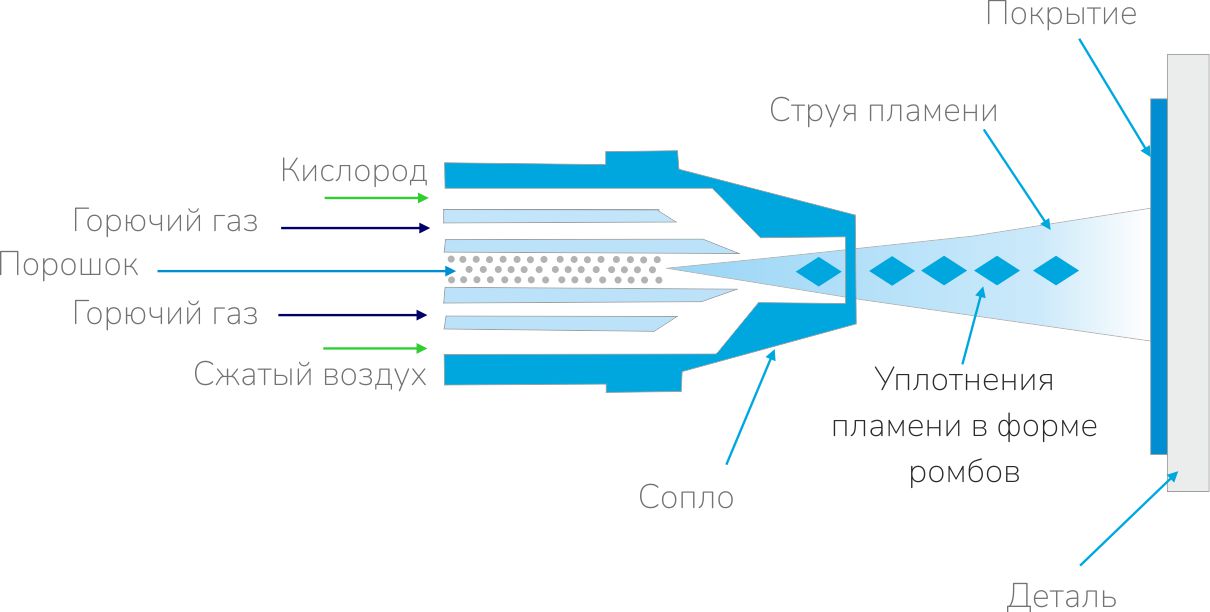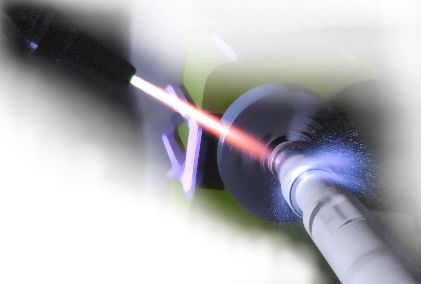High velocity oxygen/air fuel process (HVOF/HVAF)

High-speed flame spraying process is based on using of a high-speed gas jet as a source of heating and communication of kinetic energy to metal powder as a result of fuel combustion in an oxidizing medium.
Purpose:
- hard-alloy wear-resistant coatings based on tungsten carbide;
- application of heat-resistant coatings;
- corrosion and wear protection;
Customer Benefits:

- high speed of sprayed particles, due to which the obtained coatings have high density and high adhesion strength;
- the process occurs with relatively little thermal exposure to the substrate;
- ecological clean process, used as a replacement for galvanic chrome plating;
- coating spraying with minimal allowances for subsequent machining;
- high efficiency and repeatability of process characteristics owing to works automation.
The HVOF method was based on two previously developed methods: detonation and gas flame. In the detonation method, as in gas flame, acetylene is mixed with oxygen, and then this combustible mixture is mixed with a transporting gas (nitrogen) and a coating material.
Metal powder particles are accelerated to a speed of 750 m/s. The distance between the surface of the spraying part surface and the nozzle cut is 100... 120 mm. In this case, combustible gas reaches a temperature of 2700 ° C.
The advantage of the high-speed gas-flame method HVOF/HVAF compared to other spraying methods is the sufficiently high particle velocity (up to 750 m/s) and the minimum porosity of the resulting coating.
The purpose of the HVOF/HVAF method is to combine a continuous process characteristic of the gas-flame method with a relatively high coating quality, as in detonation spraying.
Advantages of the HVOF/HVAF method:
• obtaining a coating with minimal porosity (< 1%) in combination with high adhesion strength to the base material (80 MPa or more);
• due to the low roughness of the sprayed surface, there is practically no need for its subsequent machining (or required to a minimum);
• thermal impact on the part is minimal.
Application:
- aerospace;
- drilling;
- oil and gas;
- chemistry and rewinding;
- metallurgy;
- energy.
Application by parts:
- strengthening and restoration of pumps, smoke sinks and turbines shafts;
- gas thermal coatings as a replacement for galvanic chrome plating;
- tungsten carbide coatings for reduction and protection against wear of rods;
- repair of coating and spraying on new plungers, bushings, pistons, etc.;
- restoration and protection against wear of new housings of submersible electric motors (PED), rotors of rotary engines;
- high-speed spraying of housings, covers (reduced share of flushing, erosion, reduced losses), impellers (increased operating life) of pumping equipment;
- restoration and protection against wear of operating elements of shutoff valves;
- repair of babbit bearing coating;
- restoration and strengthening of turbocompressor rotors by gas-thermal spraying;
- spraying of brake rollers of drawing drum and rollers of rolling mills with wear-resistant hard-alloy coating.
